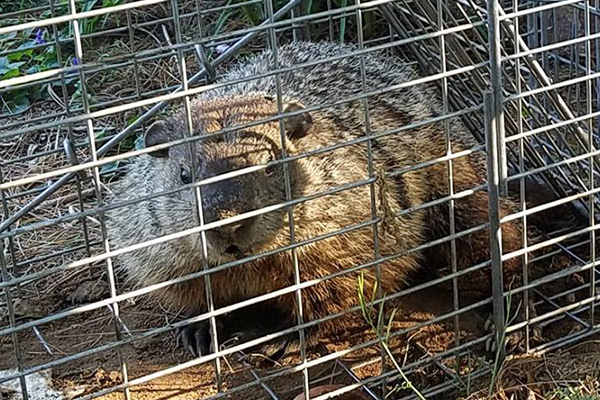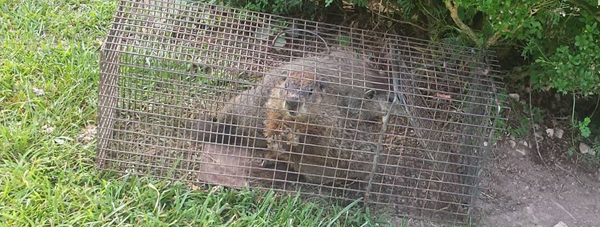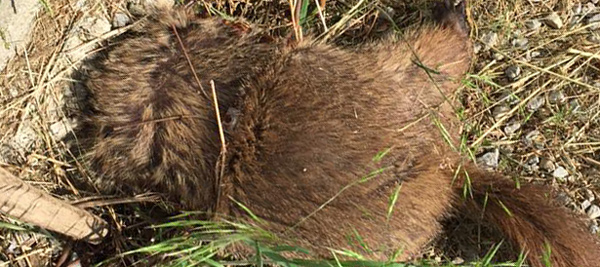- info@wildlife-removal.com
Call us for help in your town
Wildlife Removal Education
Groundhog Prevention Tips: How to Keep Groundhogs Away
Need groundhog removal in your hometown? We service over 500 USA locations! Click here to hire us in your town and check prices - updated for year 2020.
Five steps to keep away groundhogs:
- Prevention via fences
- Prevention via Home Repairs
- Prevention via Repellents
- Remove all attractants
- Get rid of their foods
Groundhogs are large rodents that are native to North America, mainly United States of America, Canada, Alaska and Central Mexico. These solitary animals are great burrowers and good climbers, and these two attributes should always be taken into consideration when dealing with them.
Being mostly herbivores, woodchucks, as groundhogs are also called, are comfortable living inside burrows that they dig under garden sheds, porches, and other man-made structures. From there, they can easily come out to feed on vegetables, apples, bananas, broccoli and other edible plants in sight. They seldom feed on snails, grubs and insects which they can also find in these locations. While in residence, groundhogs can cause structural damage and destruction of yards and gardens due to constant burrowing and search for foods. Read the guide Groundhogs or The Groundhog's Natural Diet and How It Gets Food.

The best way to be free of groundhogs is by outright prevention; blocking them from getting into your house, garden or yard. This can be done with fences, home repairs and other methods below:
Prevention via Fences
Fences can effectively keep groundhogs outside of a property. Bearing in mind that they are good both at digging and at climbing, the fence must be high enough to prevent them from climbing it and must extend below the ground level so that they cannot dig a tunnel under it. Thus the fence should be about 4 to 5 feet high from the ground and it should go about 1 to 2 feet underground too. The base of the fence should also tilt at an angle to make it hard for them to climb it.
A chicken wire fence can be easily installed to keep groundhogs away and its gaps should not be more than 3" by 3" to prevent them from squeezing through the space. Use galvanized materials to prevent the fence from rusting easily; groundhogs can chew rusted wire and make an opening for themselves. Electric hot-spot wire can also be used in the place of chicken wire as it also gives reliable results.
Use chicken wire to block any old burrows that the groundhogs have abandoned. This is because groundhogs sometimes reoccupy old, inactive burrows when they have the chance.
Prevention via Home Repairs
In the case that a groundhog infestation has been previously cleared, home repairs are essential to fix any structural damage and block or seal all cracks and holes. This will prevent them from returning.
Prevention via Repellents
1. Castor oil – this is a natural repellent that irritates groundhogs by its pungent odor. Locate the burrows and pour about one spoonful of castor oil in each burrow, after which you cover them up with dirt. In the alternative, castor oil may be mixed with water and sprayed all over the yard or garden intermittently to discourage any potential entrant. This needs to be repeated every other week or after a rainfall. It offers a temporary solution to groundhog entrance
2. Chilli pepper – or cayenne pepper. Sprinkle some into the burrows and cover with dirt or spread it all over your garden by mixing with some warm water and dispensing from a spray bottle.
3. Eggs – breaking an egg into each burrow and covering with dirt is also a common practice in repelling groundhog. Like other repellent solutions though, its effectiveness is temporary at best.
4. Ammonia – this works best when mixed with soapy water. Pour a sufficient quantity into the burrow, enough to go deep down. Leave for some time and repeat if any activity is sighted until the woodchucks are all gone. Read the guides Can You Use a High Pitch Sound Deterrent Machine Against Groundhogs?, What Groundhog Repellents Should I Use? and Does the City Or County Animal Services Department Help With A Groundhog Issues?
Remove all attractants
Groundhogs are often attracted to places where fallen trees, rock piles and wood piles are stored up or kept. These objects provide warm shelters for woodchucks to hide and live, so if these objects and other debris are removed from your yard, it would make it less attractive to groundhogs.
Get rid of their foods
Groundhogs will always go where their foods are available, they like food so much and can eat as much as 30% of their whole body weight in just one day. Their foods are mainly vegetables, fruits and other plants. They eat insects, grubs, snails too. You can get rid of these animals by using insecticides.
Some people call these animals by a different name, so you can also read woodchuck prevention methods or Should You Remove A Groundhog Yourself or Hire a Professional? for more information about keeping groundhogs away from yard or property. Read the guide Can One-Way Exclusion Funnels Be Used To Remove Groundhogs Without Trapping Them?
Best Ways to Keep Groundhogs Off of Your Property
Being mostly herbivores, woodchucks, as groundhogs are also called, are comfortable living inside burrows that they dig under garden sheds, porches, and other man-made structures. From there, they can easily come out to feed on vegetables, apples, bananas, broccoli and other edible plants in sight. Groundhogs are capable of causing great structural damage and destruction of yards and gardens due to constant burrowing and search for foods.

Being great burrowers and good climbers too, keeping them away from your property could be tricky, but a good strategy would eradicate them effectively. Below are some groundhog control methods and you can select the one that suits you.
Build Fences
Fences can effectively keep groundhogs outside of a property. The fence must be high enough to prevent them from climbing it and must extend below the ground level so that they cannot dig a tunnel under it. Thus the fence should be about 4 to 5 feet high from the ground and it should go about 1 to 2 feet underground too. The base of the fence should also tilt at an angle to make it hard for them to climb it.
Home Repairs
In the case that a groundhog infestation has been previously cleared, home repairs are essential to fix any structural damage and block or seal all cracks and holes. This will prevent them from returning.
Also, use chicken wire to block any old burrows that the groundhogs have abandoned. This is because groundhogs sometimes reoccupy old, inactive burrows when they have the chance.
Remove all attractants
Groundhogs are often attracted to places where fallen trees, rock piles and wood piles are stored up or kept. These objects provide warm shelters for woodchucks to hide and live, so if these objects and other debris are removed from your yard, it would make it less attractive to groundhogs.
Get rid of their foods
Groundhogs will always go where their foods are available, they like food so much and can eat as much as 30% of their whole body weight in just one day. Their foods are mainly vegetables, fruits and other plants. They eat insects, grubs, snails too. You can get rid of these animals by using insecticides.
How Can You Keep Groundhog's Out of Your Garden?
If you are a gardener with a range of flower beds or a good vegetable garden, one of the worst possible challenges that you can encounter is having a groundhog that moves into that garden. They will usually eat through any growing fruit or vegetables in short order, and actually getting rid of them can be a challenge as well. However, there are a couple of things that you can do that may stop a groundhog from taking up residence in your garden, but bear in mind you may also have to act reactively if these measures do not work. Read more about Is it Legal to Trap A Groundhog?

Removing Or Protecting Features That Attract Groundhogs
Food sources are one of the biggest attractions for those pesky groundhogs, so one way of keeping the animals away is to reduce the amount of produce that is being grown, or to grow different types of vegetables inside a greenhouse. However, this certainly isn't an option to suit everyone, so another alternative is to create raised beds surrounded by a wall of brick or breeze blocks, and then putting a mesh cover over the top.
Using Fencing To Keep The Groundhogs Out
The biggest challenge for those who are building a fence to try and repel a groundhog is that groundhogs are natural diggers, so they will try to dig under the fence if they can see something very attractive on the other side of the fence. This is why it is vital you install the fence at least twelve inches, if not further below the ground to stop the animals from getting under the fence, and the best way to do this is to dig a trench to the required depth, install the fence there, and then fill in the soil around the fence.
Trapping And Removing Groundhogs
Unfortunately, even the most diligent gardner will not always be able to keep the groundhogs out of the garden, and if they are still managing to find their way in, then the ultimate solution will be to trap the groundhogs. There are both lethal and cage traps available that can deal with these pest animals, so make sure you check to see if live trapping and relocation is an option in your area. You should release the animals at least ten miles away from your property, in a rural area well away from other domestic properties where they can cause further problems. Read the guide What to Do With Groundhogs After Catching Them or What to Do If You Find a Nest of Baby Groundhogs.
Go back to the Groundhog Removal page.


















